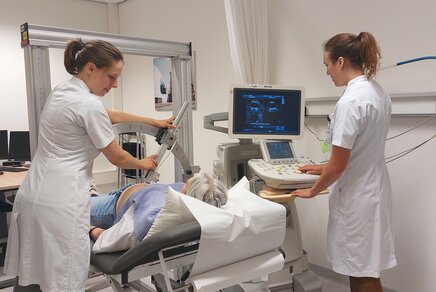Clinical physicist Carola van Pul from Máxima MC professor at TU/e
Van Pul will establish the chair 'Physics of diagnosing and monitoring' in the Departments of Applied Physics & Science Education and Electrical Engineering.

Advancing medical technology improves the quality of care. But how do you demonstrate its added value? That is what Carola van Pul of Máxima Medisch Centrum (MMC) is working on and continues to work on now that she has recently been appointed professor at TU/e, at both the departments of Applied Physics & Science Education and Electrical Engineering, in the Biomedical Diagnostics Lab. Her chair is titled 'Physics of diagnosing and monitoring' and fits well with her role as clinical physicist at Máxima MC.
"From the field of clinical physics, I am concerned with medical technological innovations and their safe implementation in direct patient care. This ranges from large scanners such as an MRI scanner, to patient monitors that can measure heart rate and blood pressure," Van Pul says. At MMC, the clinical physics department works closely with the medical technology and ICT departments to ensure that not only the medical equipment and medical software enters the hospital safely, but also integration into the care process and rollout of the associated ICT systems takes place.
Attention to the little ones
One of Van Pul's areas of focus is technology for the neonatal intensive care unit (NICU). Premature babies are especially vulnerable patients who need unique care. Some babies are born at 24 weeks, weigh only 500 grams and have severely underdeveloped organs. These babies spend several weeks or even months in an incubator in special NICU units. Modern NICUs have made tremendous progress in recent years in terms of the application of technology. Even in the coming years, there is still much to be gained in terms of safety, reliability and comfort in three major technological developments:
- Improving medical monitoring and alarm systems
In a NICU, babies' inadequately developed lungs are supported with ventilators. Breathing, along with other vital signs, is constantly monitored so that healthcare professionals are alerted in a timely manner in case of emergency.
"We know from our research that these alarms do not always require medical intervention by a healthcare professional. Our optimization in the workflow in the NICU has resulted in far fewer false alarms, a quieter room for patients and parents, and more peace of mind for caregivers in a safer environment." Van Pul shared this knowledge through a published guidance document around safe deployment of medical monitoring and alarm systems .
- Deployment of artificial intelligence
A research project of the NICU, TU/e and industry that Van Pul is leading is working on (mathematical) methods to extract more relevant information about a patient's health status from the collected data. This will allow a patient's deterioration to be noticed earlier ("early warning”), so he can be treated earlier and become less ill. "The use of artificial intelligence (AI) techniques in healthcare is still in its infancy, but has the potential to significantly improve healthcare. From clinical physics, we are working together with doctors and nurses on improving these techniques but also, for example, on methods to safely introduce and validate this new AI in practice," Van Pul explains.
- New sensors
A third important improvement in care is being realized with new sensors. On the one hand, there are signals in a NICU that are currently not continuously measured, such as movement, while every parent knows that a child who gets sick moves less. Also, new sensors are needed to measure the current signals, because now stickers are often applied to the skin, which can irritate and even cause skin damage in premature babies. Wireless sensors are needed so that parents can help care for their child, and cuddle their child, something that is very important for these children to bond well with their parents. With new sensors incorporated in a soft band around the body, in a mattress under the patient, or even remotely by using a camera, this will become much easier.
Innovative technique quickly applicable
Carola van Pul's professorship strengthens the cooperation within the e/MTIC partnership in the Eindhoven region, between MMC, TU/e, Kempenhaeghe, Catharina Hospital and Philips. The added value of this collaboration is that innovative technology can be applied more quickly in the hospital, further improving the quality of care.
"In my chair, I want to spend the next few years both optimizing current techniques in healthcare, by improving the method of measurement and developing predictive models that allow healthcare providers to diagnose earlier and ensure that patients become less ill. I also want to work towards technology that is less stressful for the patient and also less disruptive to care workers. This will improve family-centered care and facilitate parent participation. We will also work on methods to make this possible in the most optimal environment - at home - in a safe way," Van Pul says.
At the same time, Van Pul, who has already been working as a part-time associate professor at TU/e in the School of Medical Physics and Engineering at the Department of Applied Physics & Science Education since 2015, continues to teach and train young engineers, something she thoroughly enjoys doing. "We face major challenges in the coming years, both due to the aging population and a shortage of healthcare workers. Technology must be further developed to support care. I love it every day when I can enthuse young people to develop technology for healthcare."
Media contact
More on Health



Latest news


